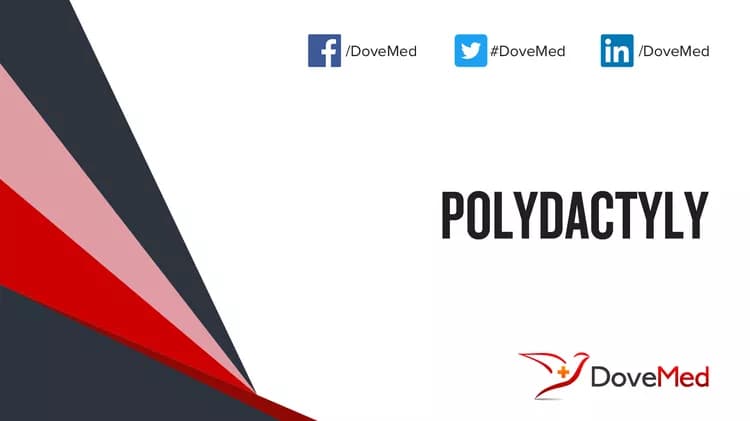What are the other Names for this Condition? (Also known as/Synonyms)
- Extra Digits
- Polydactylism
- Supernumerary Digits
What is Polydactyly? (Definition/Background Information)
- Polydactyly is a condition in which a person has more than five fingers per hand or five toes per foot. It is the most common birth defect of the hand and foot
- Polydactyly can occur as an isolated finding such that the person has no other physical anomalies or intellectual impairment. However, it can occur in association with other birth defects and cognitive abnormalities as part of a genetic syndrome
- In some cases, the extra digits may be well-formed and functional
- Surgery may be considered especially for poorly formed digits or very large extra digits. Surgical management depends greatly on the complexity of the deformity
(Source: Polydactyly; Genetic and Rare Diseases Information Center (GARD) of National Center for Advancing Translational Sciences (NCATS), USA.)
Polydactyly can be classified into the following three types:
- Preaxial: The extra digit is outside the thumb (radial preaxial polydactyly) or big toe (tibial preaxial polydactyly)
- Postaxial: The extra digit is outside the little finger (ulnar postaxial polydactyly) or little toe (fibular postaxial polydactyly)
- Central: The extra digit is between other fingers or toes
Who gets Polydactyly? (Age and Sex Distribution)
- Polydactyly is a congenital disorder and the presentation of symptoms are normally present at birth
- Both males and females may be affected
- Worldwide, individuals of all racial and ethnic groups may be affected
What are the Risk Factors for Polydactyly? (Predisposing Factors)
- A positive family history may be an important risk factor, since Polydactyly can be inherited
- Currently, no other risk factors have been clearly identified for this condition
It is important to note that having a risk factor does not mean that one will get the condition. A risk factor increases one’s chances of getting a condition compared to an individual without the risk factors. Some risk factors are more important than others.
Also, not having a risk factor does not mean that an individual will not get the condition. It is always important to discuss the effect of risk factors with your healthcare provider.
What are the Causes of Polydactyly? (Etiology)
The cause of Polydactyly may depend on the type of syndrome it is associated with. However, Polydactyly can occur in isolation as well. The following are some syndromes in which it is manifested:
- Carpenter syndrome
- Ellis-van Creveld syndrome
- Laurence-Moon-Biedl syndrome
- Rubinstein-Taybi syndrome
- Smith-Lemli-Opitz syndrome
- Trisomy 13
The inheritance pattern of Polydactyly may depend on that of the associated syndrome.
What are the Signs and Symptoms of Polydactyly?
The signs and symptoms of Polydactyly may include:
- A small, raised bump or a piece of skin that looks like a small finger or toe that is not fully-formed (nubbin)
- A complete and extra working finger or toe
How is Polydactyly Diagnosed?
Polydactyly is diagnosed on the basis of the following information:
- Complete physical examination
- Thorough medical history evaluation
- Assessment of signs and symptoms
- Laboratory tests
- Imaging studies
- Biopsy studies, if necessary
- Molecular genetic testing to check for or confirm known gene mutations that cause the conditions in which Polydactyly is present
Many clinical conditions may have similar signs and symptoms. Your healthcare provider may perform additional tests to rule out other clinical conditions to arrive at a definitive diagnosis.
What are the possible Complications of Polydactyly?
The complications of Polydactyly may include:
- Cosmetic issues, in some cases
- Complications associated with any syndrome in which Polydactyly is manifested
Complications may occur with or without treatment, and in some cases, due to treatment also.
How is Polydactyly Treated?
- There is no cure for Polydactyly, since it is a genetic condition. The treatment is usually given to manage the signs and symptoms and any complication that develops
- Treatment may include surgical removal of the extra tissue/digit to give an appearance of normalcy
How can Polydactyly be Prevented?
Currently, Polydactyly may not be preventable, since it is a genetic disorder.
- Genetic testing of the expecting parents (and related family members) and prenatal diagnosis (molecular testing of the fetus during pregnancy) in conditions with known genetic mutations may help in understanding the risks better during pregnancy
- If there is a family history of the condition, then genetic counseling will help assess risks, before planning for a child
- Active research is currently being performed to explore the possibilities for treatment and prevention of inherited and acquired genetic disorders
Regular medical screening at periodic intervals with tests and physical examinations are recommended.
What is the Prognosis of Polydactyly? (Outcomes/Resolutions)
The prognosis of Polydactyly in isolation is good, since it is not life-threatening.
- However, if Polydactyly is present as part of a syndrome, then the outcomes may be dependent upon the severity of the signs, symptoms and associated complications of that syndrome
- Individuals with mild conditions have better prognosis than those with severe symptoms and complications
- Typically, the prognosis may be assessed on a case-by-case basis
Additional and Relevant Useful Information for Polydactyly:
The following DoveMed website link is a useful resource for additional information:
Related Articles
Test Your Knowledge
Asked by users
Related Centers
Related Specialties
Related Physicians
Related Procedures
Related Resources
Join DoveHubs
and connect with fellow professionals


0 Comments
Please log in to post a comment.